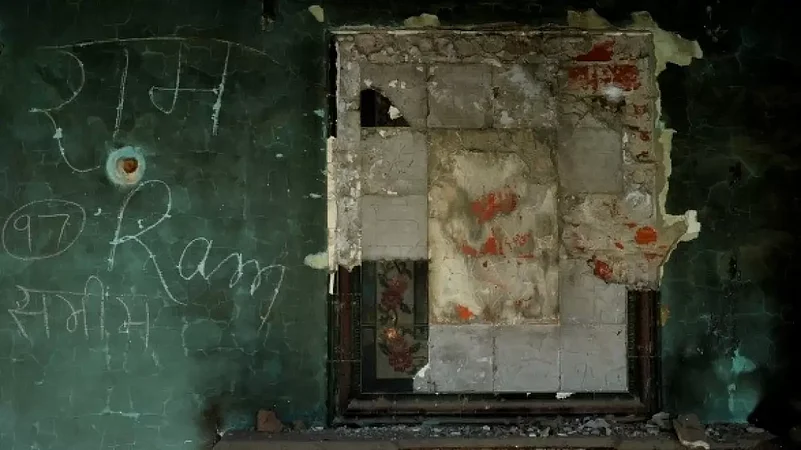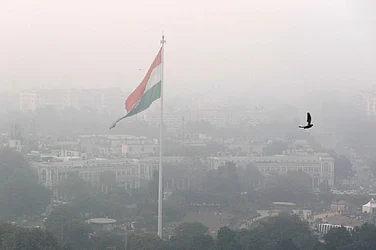They say change is the only constant in life, but that's not the case in Uttar Pradesh.
Uttar Pradesh appears to be trapped in a time loop where a similar playbook plunges the state into communal crises over and over again.
For the past decade, Muzaffarnagar has been the communal hotspot of Uttar Pradesh. In 2013, the killings of two Hindu cousins and a Muslim man broke the social contract between the Hindu Jats and Muslims and plunged the district into communal violence that killed dozens and displaced around 40,000. In 2023, a video showing a school teacher making students slap their Muslim classmate while making a derogatory remark brought forth the communal faultlines that are far from being bridged. Little has changed in the decade.
Between 2013 and 2023, the players are also more or less the same. In 2013, the Tikait brothers —regional Jat strongmen— held panchayats and gave allegedly fiery speeches that fuelled communal passions and led to violence. In 2023, they are working to strike a compromise between the accused teacher and the victim boy’s family. As panchayats with fiery speeches and strongmen striking compromises dominate the social landscapes, justice remains a distant dream.
In Muzaffarnagar riots, only a handful of cases have seen convictions and six of the seven rape cases have fallen flat as out-of-court settlements —a euphemism for ‘compromise’— were reached or witnesses turned hostile. In this month’s incident of the Hindu teacher making students slap a Muslim classmate, even an FIR remains to be filed — the police have filed a non-cognizable report (NCR) that requires a judge’s permission to start an investigation.
Prior to Muzaffarnagar’s horrors of 2023 and 2013, there were countless instances in Meerut during much of the 1980s where old-timers recall months-long ‘undeclared curfews’ and Moradabad riots of 1980. In Moradabad riots, the principal architects are both dead and cannot be prosecuted — the report indicting them was released just this month after a delay of four decades. In Meerut's Hashimpura Massacre (1987), one of the most infamous communal killings, all accused were acquitted this year and an appeal is currently pending in the Allahabad High Court.
Even in the northeast Delhi riots of 2020, justice largely eludes the victims. Targeted attacks singled out houses and persons and decades of social contract stood broken. The mobs came, rampaged through neighbourhoods, and left behind burnt houses and shops — almost everyone appeared to know whom to target.
It's not just the playbook but the post-violence story that remains more or less similar. Through the governments of various parties over the decades, investigation continues to be patchy. While the Centre-controlled Delhi Police is still investigating the 2020 Delhi riots, every mainstream party has run Uttar Pradesh since 1980 and yet investigations have witnessed multipartisan lethargy. The 1980 riots took place during Congress governments, the Bharatiya Janata Party (BJP) emerged on the scene in the 1990s and the Muzaffarnagar riots took place during Samajwadi Party’s (SP) tenure. Amid all these transitions, the patchy investigations that denied justice remained a constant.
Even as the country seethes in outrage over the Muslim boy being forcefully slapped in Muzaffarnagar, the second-generation regional strongman, Bharatiya Kisan Union (BKU) chief Naresh Tikait, sought to strike a compromise between the accused teacher and the victim boy. He said he would get the FIR revoked —which had not been filed in the first place— and that there was no point in continuing any case as the two parties have come to an understanding. The story of Tikaits is another telltale of the time loop that UP is trapped in. Just like the judicial commission report in the case of Moradabad riots indicted Shamim Ahmad and Hamid Hussain and the tussle for the leadership of the community, the Tikaits too have found themselves at the helm of every consequential communal moment in West UP in the past decade.
In 2013, the Tikaits held rallies, that were said to be fiery, that allegedly stirred the passions and triggered violence. Then, in 2020-21, they sought to build a Jat-Muslim coalition —which they are accused of breaking in the first place in 2013— over the now-repealed farm laws. Then, now in 2023, Naresh is again striking a compromise in the case of a Muslim student being slapped in Muzaffarnagar, the home turf of the Tikaits, the de facto Jat leaders in West UP. Previously, the younger Rakesh Tikait had also brokered a deal of sorts at Lakhimpur Kheri where Union minister Ajay Kumar Mishra's son Ashish Mishra was accused of running his car over farmers.
Kaviraj, a longtime political observer of UP politics, tells Outlook that after the death of Mahendra Singh Tikait, no one knows the social or political standing of the Tikaits.
“The Tikaits are not for or against anything clearly. You don’t know what's the social or political standing of the Bharatiya Kisan Union (BKU). Even as they stood with the Muslims through the farmers’ protest, no coalition emerged in the 2022 elections as the BJP won West UP against all expectations. This shows that the Tikaits and BKU built an undercurrent in favour of the BJP in West UP. In the latest Muzaffarnagar case too, the actions of striking a compromise too are in favour of BJP,” says Kaviraj, Professor, Department of Political Science, University of Lucknow.
Kaviraj adds that the Hindu-Muslim faultlines are far from being bridged in West UP. The act of Naresh Tikait to strike a compromise shows that even if those faultlines will be bridged, the likes of Tikaits with their chequered history are unlikely to bridge it.
At Outlook, we have covered India's communal faultlines over the years consistently. From the violence in Western Uttar Pradesh to Delhi and Manipur in the Northeast, we have reported and studied the various faultlines and the long wait of justice for the victims.
In her story on Delhi Riots, Rakhi Bose writes about the unending wait for justice of the Muslim victims of 2020 Northeast Delhi Riots.
In his story after the UP government made the judicial commission’s report into the Moradabad Riots (1980) public, Madhur Sharma writes about the justice denied to the victims as the leaders indicted are dead and the same playbook that plunged UP in violence from Moradabad to Muzaffarnagar (2013).
Swati Shikha in her stories traces the history of Islamophobia in Haryana’s Nuh that has become the hotspot of Hindu-Muslim tensions in the Mewat region. Five people died in an attack on a Hindu procession and the violence that spread from there enveloped neighbouring Gurugram as well where mosques and shops were attacked and a Muslim cleric was killed.
In a follow-up story, Shikha also traces the ‘bulldozer' brand of justice and explores whether it has become a tool to target minorities.
Even as Nuh or Muzaffarnagar dominate our news cycles, the rift between the Meitei and tribal communities in Manipur appears too large to be filled anytime soon. In her story on Manipur, Bose writes, “A closer analysis of the incidents that unfolded in Manipur reveals not just burgeoning ethnic tensions but deeper divides - between valley and the hills, between shifting and settled agriculture, between state and non-state, between so-called ‘civilised’ and ‘anarchist’.”


























